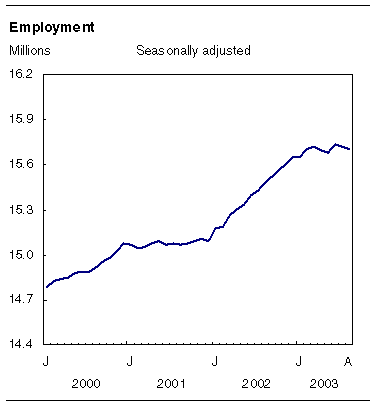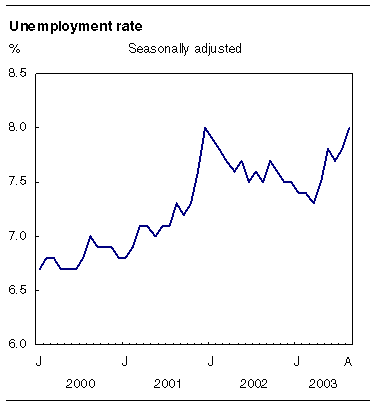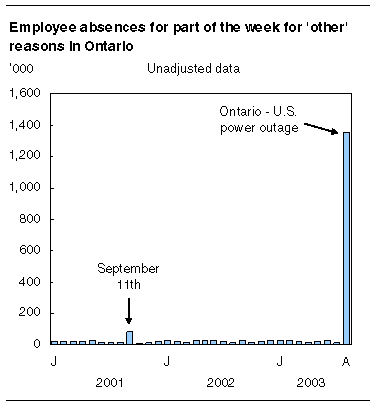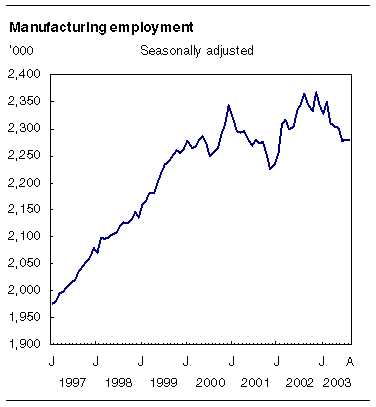
















 |
|
 |                |
Information identified as archived is provided for reference, research or recordkeeping purposes. It is not subject to the Government of Canada Web Standards and has not been altered or updated since it was archived. Please "contact us" to request a format other than those available.

|

Friday, September 5, 2003 Labour Force SurveyAugust 2003Employment edged down an estimated 19,000 in August, the fourth decline in the last five months. So far in 2003, employment has increased by only 0.3 percent, a sharp contrast to the 2.6% growth during the first eight months of 2002. In August, the unemployment rate increased 0.2 percentage points to 8.0%. The last time the rate was at 8.0% was in December 2001. 
Large loss in hours due to Ontario-U.S. power outage.While the Ontario-U.S. power outage was unlikely to have affected employment and unemployment, the blackout caused a significant number of people to miss work during the Labour Force Survey reference week (August 10 to 16). From the day of the outage on August 14 through the next two days, an estimated one in four Ontario employees (1.3 million people) missed some work as a direct result of the blackout. In total, this amounted to over 11 million hours, or 8.2 hours per absent employee. This does not include the time lost during the period of power conservation the week following the outage.
In the past, the Labour Force Survey has measured the impact of other critical events that have caused people to miss work. The 1.3 million Ontario employees absent because of the power outage was much larger than the 83,000 people who missed work because their buildings were evacuated, or factories shut the week of September 11, 2001. The 1998 ice storm in Quebec and eastern Ontario forced 150,000 people away from work for a full week, and another 390,000 for part of the reference week. In almost all industries in Ontario, workers lost hours in August. The exception to this was in the utilities industry, where many employees were required to work longer hours. Normally at this time of year, about one in six employees in the utilities industry in Ontario works more than 40 hours per week. However, in August this increased to almost one in three. 
In total, the number of hours worked in Ontario fell 5.9% from the month before (-12.4 million), the sharpest drop on record. Ontario accounted for three-quarters of the drop in hours nationwide. In Ontario, employment dipped slightly (-6,000) but a drop in the number of people looking for work caused the unemployment rate to slip 0.1 percentage points to 7.1%. A gain in manufacturing jobs in the province could not make up for a large loss in professional, scientific and technical services employment. Largest loss was in the management of companies, administrative and other support services industryNationwide, the largest loss in employment was in the management of companies, administrative and other support services industry, where employment dropped 24,000. This industry, which includes people employed in the maintenance of buildings, security services as well as call centres, has been a growth industry over the longer term, despite the decline in August. Health care and social assistance employment also fell in August, dropping 18,000. Most of this decline occurred in Quebec and Alberta. The drop in health and social assistance in August is not in line with recent trends. Compared with August 2001, when employment in the industry began its most recent upward trend, health and social assistance jobs have increased 8.2% (+127,000). A drop in full-time employment was behind the overall employment decline in August. Full-time employment fell 22,000, over half of which occurred in the two above-mentioned industries. There was also a drop in full-time work in manufacturing. The drop in hours associated with the Ontario-U.S. power outage is unlikely to have had an impact on the number of full-time workers. Overall, manufacturing employment was unchanged in August. However, so far in 2003, factory jobs have been in decline, as employment in the sector has fallen 2.7% (-62,000). According to the Monthly Survey of Manufacturing, manufacturers sliced 4.4% off shipments in the second quarter, wiping out the first quarter's gains. In August, employment in the production of transportation equipment fell, offset by small gains in a number of other manufacturing industries. 
Continued gains in public administration and constructionEmployment jumped 14,000 in public administration in August, putting year-to-date gains to 6.1%, the strongest pace of any industry. Over the last few years, public administration has been on an upward trend; however, employment in the industry remains 5% below the level prior to the large scale public service cuts of the mid 1990s. Construction employment continued to roll along in August, increasing by 11,000. So far in 2003, construction jobs have increased 3.6%. According to the Canadian Mortgage and Housing Corporation, new housing starts in July were 11% higher than a year earlier. 
Large loss in private sector employees partly offset by self-employment gainsThe number of private sector employees fell 46,000 in August, the largest one-month loss since 1995. Partly offsetting this drop was a 19,000 gain in self-employment. Over the first eight months of 2003, self-employment has increased, while the trend has flattened for private employees, as well as public sector employment. Small losses for all age-sex groupsEmployment dipped slightly in August for youth, adult men and adult women. So far in 2003, employment growth has slowed for both adult men and adult women, while it has declined slightly for youth. Despite the small decline in youth employment so far this year, the summer job market for students (those who had been attending school full-time and who planned on returning in the fall) was better than in 2002. The share of students who were employed this summer averaged 53.1%, 0.8 percentage points higher than the summer before, and the best summer employment rate since 1991. Employment declines in Quebec and New BrunswickThe largest declines in employment in August occurred in Quebec (-13,000) and New Brunswick (-7,000). Aside from a decline in health and social assistance, education and manufacturing employment also fell in Quebec. Over the first eight months of the year, factory jobs in Quebec have slid 5.0%, accounting for most of the labour market weakness in the province this year. In New Brunswick, employment fell in a number of industries, most notably natural resources, as well as food and accommodation services. The drop in employment in August brings year to date losses to 3.3% (-11,000). There was little change in employment in any other province. Available on CANSIM: tables 282-0001 to 282-0042 and tables 282-0047 to 282-0095. Definitions, data sources and methods: survey number 3701. Available at 7:00 am on Statistics Canada's website (). From the home page, choose Today's news releases from The Daily, then Latest Labour Force Survey. A more detailed summary, Labour force information, is available today for the week ending August 16 (71-001-XIE, $8/$78). The next release of the Labour Force Survey will be on Friday, October 10. For general information or to order data, contact Client Services (1-866-873-8788; 613-951-4090; labour@statcan.gc.ca). To enquire about the concepts, methods or data quality of this release, contact Geoff Bowlby (613-951-3325) or Vincent Ferrao (613-951-4750), Labour Statistics Division.
| ||||||||||||||||||||||||||||||||||||||||||||||||||||||||||||||||||||||||||||||||||||||||||||||||||||||||||||||||||||||||||||||||||||||||||||||||||||||||||||||||||||||||||||||||||||||||||||||||||||||||||||||||||||||||||||||||||||||||||||||||||||||||||||||||||||||||||||||||||||||||||||||||||||||||||||||||||||||||||||||||||||||||||||||||||||||||||||||||||||||||||||||||||||||||||||||||||||||||||||||||||||||||||||||||||||||||||||||||||||||||||||||||||||||||||||||||||||||||||||||||||||||||||||||||||||||||||||||||||||||||||||||||||||||||||||||||||||||||||||||||||||||||||||||||||||||||||||||||||||||||||||||||||||||||||||||||||||||||||||||||||||||||||||||||||||||||||||||||||||||||||||||||||||||||||||||||||||||||||||||||||||||||||||||||||||||||||||||||||||||||||||||||||||||||||||||||||||||||||||||||||||||||||||||||||||||||||||||||||||||||||||||||||||||||||||||||||||||||||||||||||||||||||||||||||||||||||||||||||||||||||||||||||||||||||||||||||||||||||||||||||
|
|
|